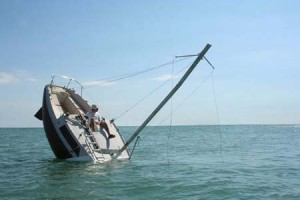If you like boating and you own a boat, eventually you will have to deal with a water leak. “Nothing good ever comes from water inside a boat” – Jim Merritt (my favorite mentor). Every submersion claim I have ever handled has had the same cause …. too much water on the inside.
Though most water leaks don’t result in a submersion, stopping them as soon as they are detected will often eliminate more significant problems and expenses including professional restoration or cleaning of soft goods (headliner, carpet, bedding), remediating mould, or replacing deteriorated wood.
So, is the water from above or below? Remember, don’t taste it. To begin the process, put on your thinking cap and make your best guess. If water is accumulating in the bilge, assume the water is coming from below. Clean and dry the area to assure you have a leak and not a spill. If the direction of the source of the water is unknown, coat the bilge and the area around the bilge with powder, the trail of water through the powder will point you in the right direction. If you use cleaning powder, you can then use a rag and stop procrastinating that bilge cleaning job. You can continue using the powder trick in the direction of the leak until the source of the water is located.
Normal sources of water include propeller shaft seals, rudder ports, through hulls, and hoses. Any below waterline component can leak with the boat in a static condition, though some leaks are intermittent. Sometimes a shaft seal will leak with a shaft in a particular orientation. Some systems only leak while operating, particularly if the leak itself is above the static waterline. The engine(s) cooling systems and exhaust systems are primary candidates for leaks. The generator, air conditioner, waste system, and other raw water components/freshwater systems are potential sources to consider. A freshwater system leak is usually indicated by a cycling pressure pump. (No, it is not supposed to do that).
Determining the level of the waterline inside the boat can be tricky if there is no exterior through hull or other simple reference point. You can always detach a hose from a through hull and hope it is long enough to reach above the water level, or you can use a old trick (like before the Greek and Roman empires old). Get a long clear hose, fill it in the water beside your boat. Put your hand on one end and pull it to the place you want to check. Leave the other end of the hose in the water beside your boat, route part of the hose below the waterline and lift the end you’re holding above the waterline. Remove your hand to let air in the hose and the sea water level will be revealed.
If you located the leak and think you fixed it, make sure you have cleaned and dried the area, monitor it again in the near future to confirm you fixed the leak and take this task of your procrastination list.
If the leak is from above, put that thinking cap back on and begin by making your best guess of the source. Remember the construction method of most fiberglass boats includes a two piece deck (similar to the hull and hull liner); the lower piece or liner can often mask the true source of the leak and throw the leak detective off the trail. Vinyl or cloth head and side liners can also redirect the leak, resulting in the appearance of the leak quite a distance from the actual source. Think gravity, the water came through the deck at a point higher than the drip you are seeing in the cabin. Before you start taking things apart, utilize other resources available. Boat owners groups are often an excellent resource and other Sea Ray owners have likely skinned this cat. Manufacturers are also a wealth of knowledge and the Catalina engineering department is incredibly helpful and responsive.
If “non destructive” means of locating the deck leak are not resolving the issue, you will need to continue more active techniques. Consider hose testing for leaks. Realize that some leaks are very slow and this procedure can be tedious. Test only one potential leak source at a time. Spraying the whole foredeck only confirms that you have a leak.
Depending on the type of the installation, re-bedding hardware may be the next logical procedure. Realize that bedding compounds (caulking) has a finite life. Choose your new products appropriately, spend the extra money for strong, long lasting sealant, though be careful about the adhesive properties of some of these compounds.
Removing headliner is a daunting and troublesome task for most of us. However, once it is gone, the answers are often clear and apparent. And, just like in your house (think popcorn ceiling) that fuzzy headliner may be passé.
If you think a leak is from a tank, consider a dye test, it is cheaper and potentially less destructive than a pressure test. Air pressure can be used to test tanks and systems, depending on the configuration and soap bubbles can be helpful.
We often hear condensation blamed for high moisture conditions in boats. While condensation is a reality at certain times of the year, it is fairly easily controlled with heaters or de-humidifiers. And of course, our favorite way to reduce moisture in the cabin is to use the vessel regularly. Open it up when the sun comes up; get the air flowing by moving the vessel through the water with the foredeck hatch open. Ventilate the vessel, be creative. There are many ways to allow ventilation and still restrict moisture intrusion, but the best one is to take a cruise.
P.S. Remember: fungus deterioration in wood requires four things: wood, moisture, air and the proper temperature. You can only control the moisture.
This article was edited on February 26, 2016.
